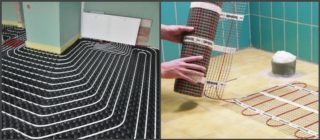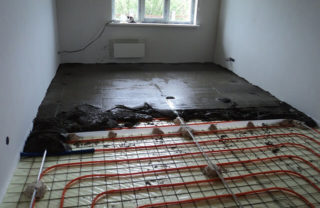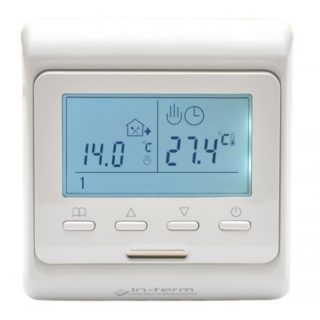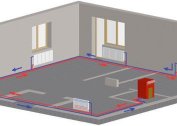When heating the home with the help of underfloor heating systems, the heated air comes from below, which allows you to maintain a comfortable microclimate and not to dry the air in the house. The heat is evenly distributed in space, there are no temperature differences in the room. The equipment allows you to adjust the degree of heating in each room separately for maximum comfort of all family members.
Underfloor heating device
Underfloor heating systems come in several forms. The main ones are water and electric. The latter, in turn, are divided into cable, infrared film and heating mats. Regardless of the type, they all have a similar design, which consists of the following layers:
- The base surface of the floor.
- Waterproofing coating.
- Thermal insulation.
- Heating system of pipes, cables or thermomats.
- Cement screed that envelops and fixes pipes.
- Finish flooring.
Warm floor can serve as the sole source of heating or additional together with the central one. The temperature is adjusted manually or automatically.
The optimal temperature for heating a warm floor of various types
The documentation that accompanies the system kit prescribes the maximum temperature values that can be set on specific equipment. Often on the thermostat you can see a value of + 40C. However, building codes establish restrictions: the maximum temperature of a warm floor for residential premises should not be more than +26 C. But there are several nuances. The setting itself is affected by the room itself. For example, in the bathroom for a short time set a higher degree of heating (+30 C) in order to get rid of excess moisture. On a cold balcony you will need a more powerful system, as the floor there will quickly give off heat and cool.
The value of maximum heating is affected by flooring. Ceramic tile is considered the most optimal option. It is not subject to deformation from elevated temperatures, quickly heats up and cools. For linoleum, laminate or carpet, the value should not exceed + 26C. Otherwise, they dry out and crack from overheating.
Temperature readings depend on the type of underfloor heating. For the water system, the main element is a pipe laid on the floor base and poured with a cement screed 6 cm thick. Water moving through the pipe acts as a heat source in the system. Normal heating of the warm floor should be + 30C. Given the further installation of the flooring, its value decreases by several degrees and becomes comfortable.
To warm up the flooring to + 26 ° C, it is necessary that the temperature of the coolant in the pipe reaches + 55 ° C when supplied and + 45 ° C in the return. At the same time, water floors warm up for a long time. It takes 12-20 hours to fully heat up (the time depends on the area of the room). However, heat begins to be felt after 3-4 hours. This situation is explained by the relatively low thermal conductivity and the need for heating the cement screed. But the water floor also cools for a long time - after a complete shutdown, the heat can hold for more than a day.
The cable system type assumes maximum heating of the main element to +85 C, and its insulating material must withstand temperatures of +100 C.
Installation of thermomats allows you to quickly warm up the floor to the optimum + 26-28 C and ensure a comfortable atmosphere in the house. The electric floor heats up much faster than water. The system itself reaches the set parameters on average in 10-15 minutes, and a complete screed heating takes about 10 hours, regardless of the area of the room. Heat begins to be felt after 3-4 hours. Cooling is also pretty fast - about 12 hours.
The infrared type of construction is a modern development in the form of a thin film that combines most of the advantages of other systems. Due to its small thickness, the film can be stacked under linoleum, carpet, parquet, laminate, etc. It is absolutely not necessary to fill the screed, it is enough to lay a layer of plywood and vapor barrier between the film system and the floor covering. The maximum heating temperature of the system is +55 C, therefore, overheating of the coating and its destruction are excluded.
Infrared floor heating has a unique method of heat transfer, which is radiation. It carries out heating of objects that give off heat to the air. This type of system heats up in record time, the heat is felt already in the first hour of its operation. Cooling is the same as that of the cable floor.
Climate control methods
The temperature control of a water-type warm floor occurs due to the complete cessation of the supply of coolant, or by mixing the hot supply with a cold return to the desired value.
The first option is the simplest and most reliable. A pump and a non-return valve are installed in the supply system, and a thermostat is mounted on the non-return manifold. Hot coolant (+ 70-80 C) is supplied to the warm floor, water gives off energy to the room and gradually cools down. As soon as the system overheats and the return temperature exceeds the value set by the thermostat, the pump switches off. The flow of coolant stops, the equipment goes into standby mode. As soon as the water cools, the pump starts again.
The second option involves installing a three-way valve or mixing valve in front of the pump. These devices add to the hot supply of cool return. Thus, the feed water is diluted to the desired temperature. The degree of mixing is adjusted manually or automatically.
The heating of electric underfloor heating is regulated by means of a thermostat and a temperature sensor connected to it, which is installed near the heating cable. As soon as the system warms up to the value set by the thermostat, the voltage supply to the heating elements stops.
Depending on what equipment is installed in the system, temperature control occurs in several ways.
- Manual adjustment is carried out manually, based on the personal feelings of users. To understand how effective the changes are, a two-hour break must be maintained between them. With this regulation, the data will be inaccurate.
- Individual or zonal settings for underfloor heating occur due to sensors installed in each room. In this case, the microclimate is regulated separately for each room by room automation. It maintains the set temperature of the heat carrier, air or surface. In this case, continuous user involvement is not required. In addition, automation saves energy.
- Group regulation is notable for accurate readings. It increases or decreases the temperature, increases or decreases the flow of hot coolant in automatic mode. In group settings, the overall value for the entire system as a whole is set.
- Another way is a valve with a thermal head.If it is necessary to change the heating level, the capillary tube regulating the valve opening expands or narrows. This continues until the desired mode is configured. Adjustment is automatic. Depending on what temperature the air in the room, the automation determines the degree of heating and opens or closes the valve.
There is a method that combines individual and group modes of climate control - a complex type. In this case, equipment is installed to adjust the heating of warm flooring throughout the apartment. Additionally, automation is mounted for each room separately.






